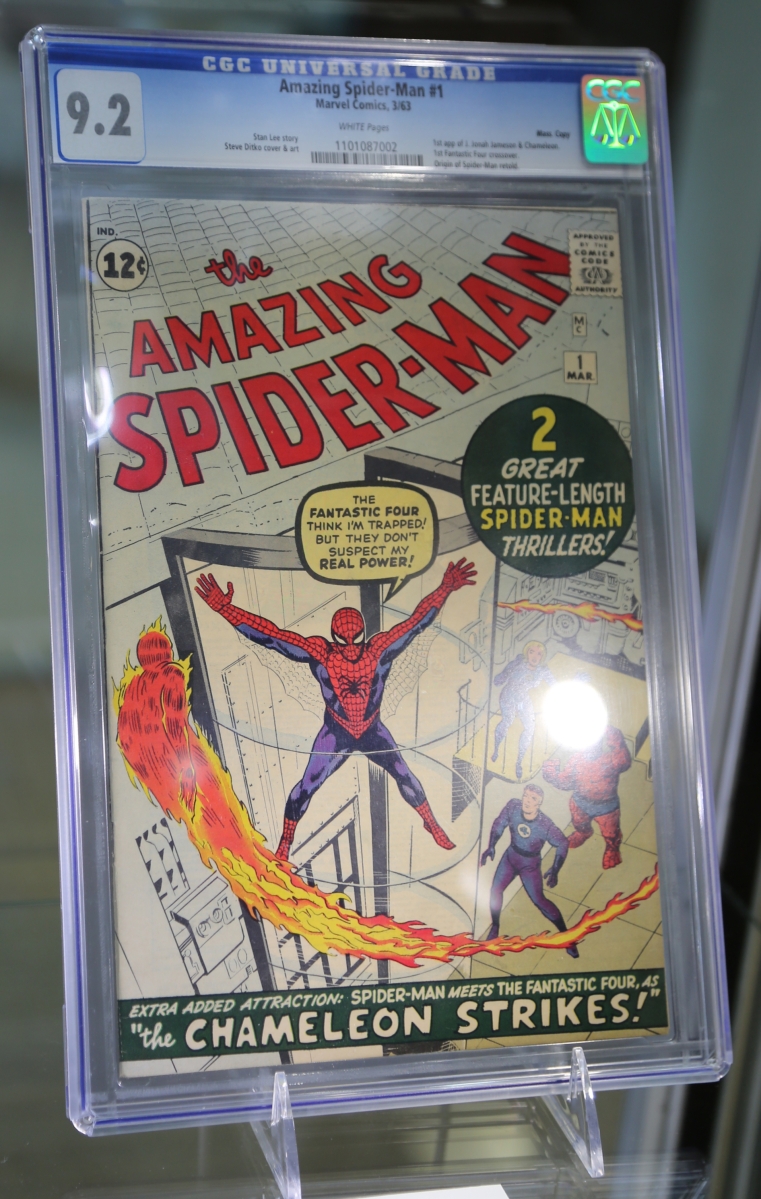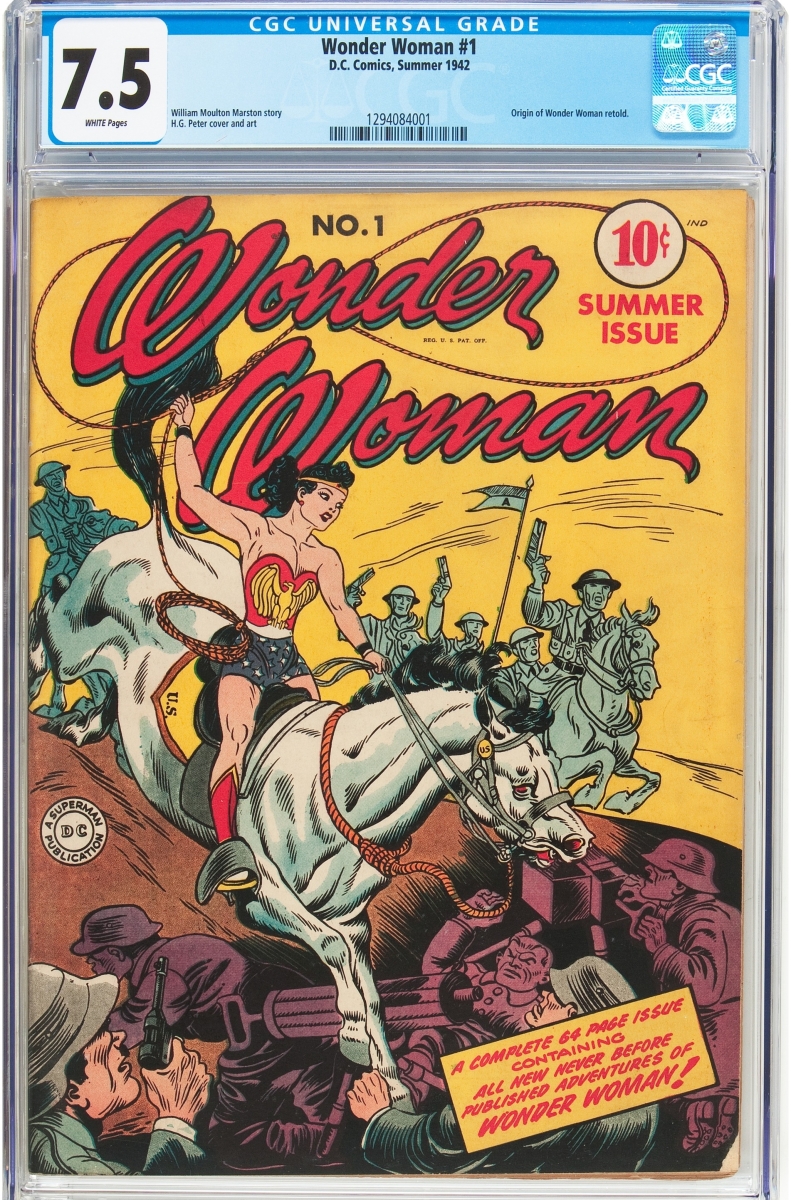
The phone bidder emerged victorious in a bidding battle with the internet on Fritz the Cat’s cover art as Kathleen Guzman hammers down to a round of applause from the room.
Review and Onsite Photos by Greg Smith, Catalog Photos Courtesy Heritage Auctions
NEW YORK CITY – With so much hype around Hollywood’s never-ending stream of modern day action hero movies that have been effortlessly propping up the box office for the past few years, it is easy to lose focus on the heroes’ modest and paper origins. That is, unless you have been following Heritage Auctions comic and comic art department, which has been building a formidable market in this field over the past decade.

The top lot of the day, Robert Crumb’s original cover art for Fritz the Cat, published by Ballantine in 1969, went way over estimate to bring $717,000.
More than 15,000 bids were placed at the firm’s May 18-20 comics and comic art auction as collectors tuned in and snapped up unique original artworks and rated comic books that spanned first appearances to early editions. With material hailing from the Platinum through Modern Age, the successful 1,370-lot sale grew surely and steadily as the weekend rolled on to reach a robust total sales figure exceeding $8.3 million.
“It was right up there as one of the top five sales we’ve ever had,” said Barry Sandoval, director of operations for comics and comic art at Heritage. “We’re really the only comic sellers that do the traditional live auction format. The reason we print catalogs and take the lots around to major cities and hold the live sale is because, for the best high-end material, the pieces sell better.”
Kicking off the three-day auction on Thursday was the firm’s signature Platinum Night, which featured more than 80 lots of the highest-quality material that would appear throughout the weekend. A handful of serious collectors gathered in the Omni Berkshire Place in New York City to watch auctioneer Kathleen Guzman, adorned with her Wonder Woman tiara, sound off the storied lots one by one.
Bidding was competitive between the internet and the phone, with the room chiming in every now and then. To give a sense of the action, it took only 16 lots to reach the $1 million mark, and by lot 35, the sale had grossed $2.2 million. For the 83 lots in the evening session, the average sale price was $50,000.
As the bidding started to heat up, my mind wandered and began to imagine a story line where all of the superheroes were fighting to achieve the top lot in the sale. Every bid for each hero would empower each character as they battled their way to the top of the block. Set on top of a skyscraper in Manhattan, the superheroes would punch, kick, blast and throw each other off the top of the building until only one remained – the most valuable character. It was exciting. Captain America, Superman, Thor, Spider-Man, Iron Man, Wonder Woman – all were there.
But the story took a very unforeseeable turn when Fritz the Cat, who had just been walking by the building, decided on a whim to walk in and ride the elevator up to the top floor. Out of all of the characters in the sale, Fritz was not known to be the prize fighter. So without much thought or consideration for the brawl around him, he tiptoed around and found what interested him most. “Have you ever been with a cat?” he would have asked Wonder Woman. “Excuse me?” she would have sneered. Everyone would have froze, mouths agape. They all would have tried to throw Fritz from the building, but they could not. He was untouchable.
Fritz the Cat, with his thin body and scraggly coat, reeking of cigarettes and alcohol, had more bids than anyone. He was the most powerful. Not one to engage in the fight, he would calmly meander out the same way he came in. Afterward, a scene would feature all of the heroes lying around on sofas, speech bubbles popping up with “What the…” and “How did he just…” Left entirely speechless, one or two of the heroes would begin to question reality. In fact, we all would. Perhaps this is why universes should not mix.
Snapping back to the Omni, the bidding war taking place between the phone and the internet, where Fritz the Cat, Robert Crumb’s derelict and lovable layaway character, was going sky high. The original cover art image featured Fritz on the sofa with his girlfriend, Charlene, who was inadequately covered up. It was published by Ballantine in October 1969 and was used as the lead image on Ralph Bakshi’s adaptation of the character for the silver screen in 1972. Fritz the Cat would be the first feature animation film to receive an X rating in the United States. The ink on Bristol board would go on to sell to a phone bidder for $717,000, an auction record for the artist.
“Robert Crumb came into prominence by doing undeground comix, he was notable for his old-fashioned style,” said David Tosh, comics cataloger at Heritage. “His work had the look of a 1930s/40s newspaper comic book artist. His content was outrageous: sex and drugs. He’s a very prolific artist, he couldn’t stop drawing.”

Nazis, bondage and murder fueled the bidding on the top comic book lot of the sale. In near-mint condition, Suspense Comics #3 sold for $262,900. The issue is currently at #26 on Overstreet’s top 100 Golden Age comic books.
Of the top five lots in the sale, three were by Crumb, who remains one of the most coveted underground comix artists of all time. Fetching $191,200 was a four-page original art story called “The Confessions of Robert Crumb,” which is as close as a comic artist will get to drawing a self-portrait. “Oboy, I’m feeling devilish today!” writes Crumb in the opening box as he sits at his drafting table. “There’s no telling what twisted perverted drawings I’ll come up with! …and ya know folks… my life’s an open book! Up to a point!”
Also ringing in at $191,200 was Crumb’s second take on his Keep on Truckin‘ comic, which appeared first in Zap Comix in 1968. This ink on Bristol board artwork featured a more comical take on the popularity of his first, suggesting alternatives like “Keep on Chunkin” and “Keep on Toodlin.”
Traditional comics from every age found a flurry of interest among bidders around the United States. Achieving the second highest lot of the sale was a near-mint Mile High copy of Suspense Comics #3, selling for $262,900. The very rare and key issue from the Golden Age was published by Continental Magazines in 1944.
“The issue is so sought after because it’s a crazy and bizarre cover,” said Barry Sandoval, while looking at the piece in the case during preview. The image featured a group of hooded men with swastika symbols on their arms in mid-ritual around a campfire, the lead figure about to ceremoniously plunge a dagger through their tied-up female hostage, with her savior reaching over the hill above, fighting to her rescue. The 9.2-rated comic is the finest copy currently known.
Another Golden Age comic that flew high was Wonder Woman #1, produced by DC in 1942. The 7.5-rated copy achieved $95,600 ahead of the character’s premier Hollywood movie out June 2.
Finally and regardless of a 1.0 condition rating, a Superman #1 produced by DC in 1939 sold for $83,650.

“Almost all of his images have become iconic,” said Joe Mannarino, director of comics and comic art in New York, of Frank Frazetta. Selling for $191,200 was “In Pharaoh’s Tomb,” an oil on canvas work that originally debuted in a 1978 TV Guide and appeared as an advertisement for Battlestar Galactica.
“When you have the finest known copy of something, that’s always going to do great in our auctions,” said Sandoval. “But the Superman #1, in fair condition, sold for $83,650. We also had an Amazing Fantasy #15 rated 6.0 that sold for $50,190, and another of the same issue rated 4.0 that sold for $35,850. So those are books where we’ve had many better copies over the years, but collectors are still trying to get ahead of the curve. In two years from now that price might be cheap.”
From the Silver Age, highly rated first appearances took the cake. Coming in at $143,400 was the first Silver Age appearance of Captain America in The Avengers #4. The example was tied with three other issues for the highest rated copy known and featured an action-packed lineup with appearances from Iron Man, Sub-Mariner, Giant Man and the Wasp.
Also among the top Silver Age lots was The Amazing Spider-Man #1, rated 9.2 that brought $95,600. Tales of Suspense #39, Iron Man’s first appearance produced by Marvel in 1963 and rated 9.4, went for $95,600. The Avengers #1, also with a 9.4 rating, found a buyer at $89,625. And finally, The Incredible Hulk #1 in an 8.0 rating sold for $89.625.
Prices include the buyer’s premium.
Heritage’s comic and comic art department holds weekly online sales and their next live auction animation art sale is on July 1.
For further information, 800-872-6467 or www.comics.ha.com.























